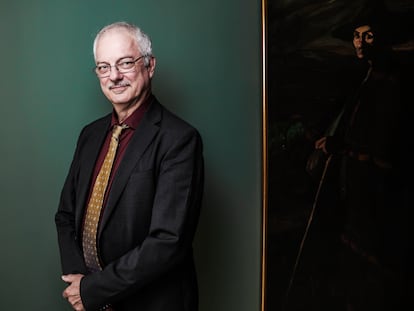The neuroscience of cancer: How tumors hijack the nervous system to grow faster
Research shows that electrical currents from brain activity can promote the growth of cancers. But this process could be reversed with drugs already approved for neurological and circulatory diseases
U.S. neurologist Michelle Monje has spent years noting a surprising pattern in some of her patients with glioblastoma, the deadliest type of brain cancer. After the primary tumor is removed, the cancer reappears after a while; but it does not reappear in just any part of the brain, but rather in the area that the patients used the most for their work. In the case of a ballet dancer, it reappeared in the area of the cerebellum that controls balance. In a writer, it grew back several times in the area of the cerebral cortex which controls language.
“It is a pattern recognized by many neuropsychiatrists,” says Monje. “I wonder if the fact that these people have greater development and plasticity in these areas of the brain made them more at risk of suffering from this type of tumor,” adds the researcher from Stanford University. Monje is one of the leading scientists in cancer neuroscience, a new discipline that tries to unravel the connection between brain activity and cancer.
In a recent study, Monje and other neurologists looked at which areas of the brain were activated in patients with glioblastomas when they performed simple cognitive activities, such as looking at the picture of an umbrella and saying the word umbrella.
When the patients responded, the Broca area that controls language was activated, as well as other brain areas invaded by the tumor. The cancer had reorganized the brain’s speech circuits, based on the synapses between neurons, in order to connect to them. Electrical currents generated during these cognitive tasks reached the tumor and promoted its growth. The more the affected areas lit up, the worse the prognosis was for the patients, who also gradually lost their ability to speak. It is likely that the neuronal overstimulation caused by the tumors is why many patients suffer epileptic seizures and cognitive problems.
Brain tumors, gliomas and glioblastomas represent around 2% of all tumors diagnosed each year. Despite their low incidence, they represent a significant challenge for medicine, as they respond very poorly to treatments. Gliomas represent 15% of all childhood tumors and are the leading cause of death from cancer.
The interaction between the nervous system and cancer extends to other organs through the nerve branches that go from the brain to the rest of the body, extending 93,200 miles (150,000 kilometers).
Malignant cells advance along the nerves and receive key molecules from them to grow. Tumors with more nerve branches have a worse prognosis in the prostate, stomach and pancreas, according to studies in animals and analyzes of patient samples. In some cases, malignant cells from a primary breast tumor can migrate to the brain, nestle in it, connect to neurons, and metastasize, making them much more deadly than the primary tumor.
The interaction between the nervous system and cancer is complex and varies between each organ. In the stomach, the neurotransmitter acetylcholine promotes the expansion of tumor cells, but in the pancreas it has the opposite effect and slows tumor progression.
The role of the nervous system in cancer growth has been overlooked for a long time. In 1899, the Spanish physician and Nobel Prize winner for Medicine Santiago Ramón y Cajal was the first to describe a growth pattern of nervous tissue in which glia, a type of nerve cell, grew around neurons, as if they were their scaffolding.
At the beginning of the last century, German pathologist Hans-Joachim Scherer observed the same structures in samples from patients with brain cancer: tumor cells grew around neurons, and it was very difficult to determine where the tumor ended and healthy brain tissue began.
This research remained at a dead end until 10 years ago, when the doctor and researcher Paul Frenette, from the Albert Einstein School of Medicine (United States), presented the first tests in animals and patient samples, which showed that the more nerve endings prostate tumors have, the more aggressive they are and the worse they respond to treatment.
Since then, similar connections have been observed in other organs and this new field of research has exploded, according to Frank Winkler, a neuro-oncologist at Heidelberg University Hospital (Germany) and leader in this field in Europe. “Now we know that tumor cells form connected networks and communicate with each other just like neurons do,” he explains. “Many of the biochemical processes that we observe are the same ones that take place in an embryo to form all the organs of the body. The tumor behaves like any other organ. It doesn’t invent new mechanisms to grow, but rather takes over the ones that are already invented,” adds Winkler. His team has perfected a new microscopy technique to study the formation of tumors, how they communicate with other brain cells and their real-time progression and reappearance in live animals. These data are crossed with those observed in patients with brain tumors to try to better understand this dimension of cancer.

Neuroscientist Manuel Valiente, from Spain’s National Cancer Research Center, believes that cancer neuroscience can clarify not only the role of the nervous system in driving primary tumors, but also brain metastases, which are 10 times more frequent than glioblastoma. In addition, “investigating these connections could shed light on why brain tumors cause cognitive damage in 44% of patients, and perhaps help prevent them, so their minds aren’t affected as much while they’re on treatment,” he explains.
One of the explanations for why this field is still taking off is that traditionally cancer research teams did not know how to analyze nerve tissue, nor neural activity, which is based on a complicated interaction between small electrical currents and the production of biochemical compounds. Physicist and neuroscientist Liset Menéndez de la Prida, head of the neural circuits laboratory at the Cajal Institute, is a specialist in this type of analysis. Together with Valiente, she is participating in a $3.6-million European project funded to develop new photonic tools to measure the electrical and biochemical activity of cancer cells within the brain. “We are seeing a whole paradigm shift and the birth of a new field,” she says.
Manuel Sepúlveda, an oncologist at 12 de Octubre Hospital in Madrid, explains that brain tumors, both glioblastomas, the most aggressive, and low-grade gliomas, originate from mutations in glial cells, which are another type of nerve cell. “The nervous system by itself would not initiate it, but it does encourage it and promote its growth,” he points out. “We are seeing that there is a new way to study this type of tumors, although the importance of the interaction with the nervous system has yet to be determined and whether it can be stopped with drugs.” Sepúlveda recently participated in a clinical trial that has shown how a drug directed at specific mutations in gliomas can significantly delay the recurrence of cancer after surgery. There are patients who have not suffered relapses or epileptic seizures for six years.
There are drugs that have been approved to treat mental, circulatory and neurological diseases that affect some of the mechanisms observed and that could interfere with the development of tumors, both in the brain and in other organs. Researchers have begun clinical trials of perampanel, an anti-seizure drug that blocks glutamate-mediated communication between tumors and neurons. Another trial in patients is studying the effects of meclofenamate, a pain medication, in blocking communication between tumor cells in patients with glioblastoma.
“A whole new field of therapeutic interventions in tumors with a very poor prognosis is opening up,” says Michelle Monje, who believes that targeting the nervous system could become a new pillar of oncology in the same way that immunotherapy has cured tumors that were previously a death sentence. “Blocking the communication between the tumor and the nervous system may not be enough to eliminate it, but I think it will be absolutely necessary to achieve it,” she concludes.
Sign up for our weekly newsletter to get more English-language news coverage from EL PAÍS USA Edition

